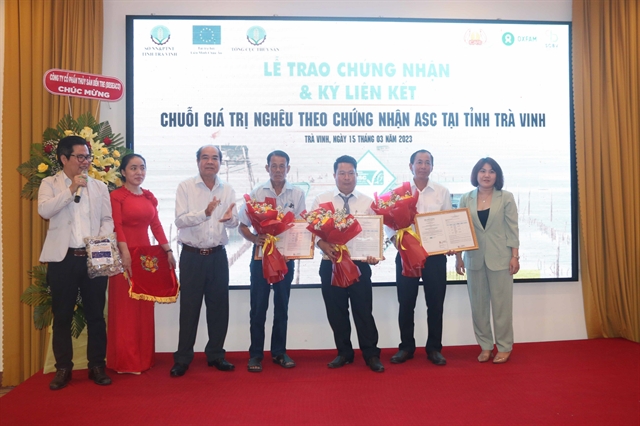 Economy
Economy


|
| Representatives of three clam breeding co-operatives in Trà Vinh Province receive Aquaculture Stewardship Council (ASC) certification for their bivalve molluscs on Wednesday. – VNA/VNS Photo Thanh Hoà |
TRÀ VINH – Three clam farming co-operatives in Trà Vinh Province with a total area of 433ha have been awarded the Aquaculture Stewardship Council quality certification.
They are the Thành Công Co-operative in Cầu Ngang District’s Mỹ Long Nam Commune, Tiến Thành Clam Co-operative in Châu Thành District’s Long Hoà Commune and Long Thành Agriculture Co-operative also in Long Hoà.
The province Department of Agriculture and Rural Development and the International Collaborating Centre for Aquaculture and Fisheries Sustainability (ICAFIS) held a ceremony to hand over the certificates to the co-operatives on Wednesday.
Also at the ceremony, the Bến Tre Seafood Joint Stock Company and the Hưng Trường Phát Aquamarine Product Joint Stock Company in Bến Tre Province and the Lenger Seafoods Việt Nam Company Limited in Nam Định Province signed an MoU to develop value chains for clam farming with the three co-operatives, the province Fisheries Sub-department and ICAFIS.
Trần Văn Dũng, deputy director of the department, said the ASC certifies responsibly farmed seafood that minimises negative impacts on the environment and communities and proper implementation of labour regulations.
Products certified as meeting ASC standards are preferred in many markets, especially the EU, he said.
The Cửu Long (Mekong) Delta province is only the third clam farming area in the world to get the certification, he said.
It would help the province export its clams, enhance its brand and add value, he pointed out.
With a coastline of 65 kilometres, the province has excellent conditions for breeding clams in alluvial grounds and large estuaries along coastal areas.
But its clam farming has faced difficulties in the past because of the small scale and lack of brand name, processing facilities and steady demand.
It has seven clam breeding co-operatives which farm a total of 1,000ha and have an annual output of 4,000 - 6,000 tonnes.
It has identified clams as a key aquaculture species that offers high value, helps create jobs and improves incomes, especially of poor people.
It plans to increase the total clam farming area to 3,300ha by 2030. – VNS




